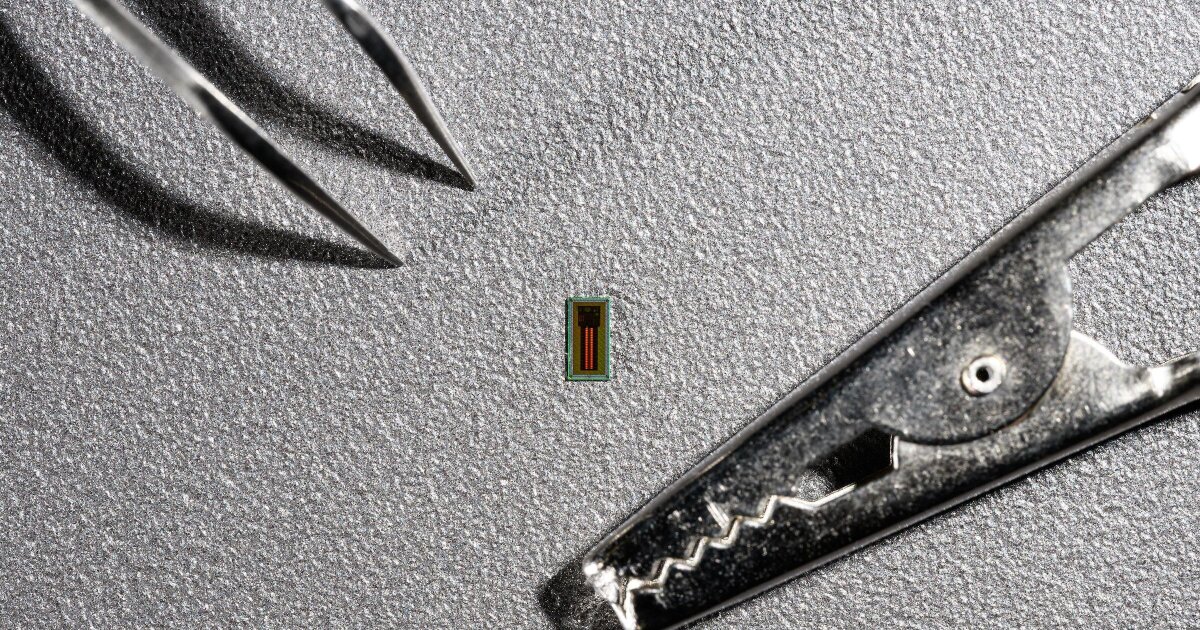
The brain-machine interface race is on. While Elon Musk’s Neuralink has garnered most of the headlines in this field, a new small and thin chip out of Switzerland makes it look downright clunky by comparison. It also works impressively well.
The chip has been developed by researchers at the Ecole Polytechnique Federale de Lausanne (EPFL) and represents a leap forward in the sizzling space of brain-machine-interfaces (BMIs) – devices that are able to read activity in the brain and translate it into real-world output such as text on a screen. That’s because this particular device – known as a miniaturized brain-machine interface (MiBMI) – is extremely small, consisting of two thin chips measuring just 8 mm2 total. By comparison, Elon Musk’s Neuralink device clocks in at comparatively gargantuan size of about 23 x 8 mm (about 0.3 x .9 in).
Additionally, the EPFL chipset uses very little power, is reported to be minimally invasive, and consists of a fully integrated system that processes data in real time. That’s different from Neuralink, which requires the insertion of 64 electrodes into the brain and carries out its processing via an app located on a device outside of the brain.
“MiBMI allows us to convert intricate neural activity into readable text with high accuracy and low power consumption,” said Mahsa Shoaran who heads EPFL’s Integrated Neurotechnologies Laboratory. “This advancement brings us closer to practical, implantable solutions that can significantly enhance communication abilities for individuals with severe motor impairments.”
Like other BMIs, the new chip basically monitors electrical activity in the brain and, armed with datasets from previous brain-monitoring efforts, converts that activity into an output. In this case, the MiBMI is able to read brain signals that are formed as someone imagines drawing a letter and output those signals as text.
Unlike the Neuralink device which was implanted in a human patient earlier this year, the new MiBMI chip has yet to be tested in a live setting. However, it was fed real-time neural recordings gathered from previous brain interface tests and achieved a 91% accuracy rate in converting neural activity into actual text.
Neural shorthand
Part of the success of the new chip lies in a new way of reading the language processing cues sent by the brain. While working on their chip, the EPFL researchers found a series of very specific neural markers that fire when a patient imagined writing each letter. They termed these markers distinctive neural codes, or DNCs.
The DNCs then became a sort of shorthand for each letter which allows the MiBMI chipset to only have to process the markers themselves. These clock in about a hundred bytes each, instead of the typical thousands of bytes of neural data associated with the imagining of each letter. This was a major factor in allowing the chips to achieve their work in less space using less energy. The researchers say the DNC system will also lead to a reduction in training time for individuals fitted with the chip.
The MiBMI is currently able to decode 31 different characters which, the researchers say, is a record for similar integrated systems. They feel they can eventually get the system to decode up to 100 different characters.
As with other BMIs, the EPFL chip is seen as a way to bring the ability to communicate to those who can’t, such as people suffering from ALS or other severe motor impairments. The researchers are currently exploring other uses for their system that could go beyond text processing.
“We are collaborating with other research groups to test the system in different contexts, such as speech decoding and movement control,” says Shoaran. “Our goal is to develop a versatile BMI that can be tailored to various neurological disorders, providing a broader range of solutions for patients.”
The research that led to the new MiBMI’s creation has been described in a paper published in the latest issue of the IEEE Journal of Solid-State Circuits.
Source: EPFL
Source of Article
